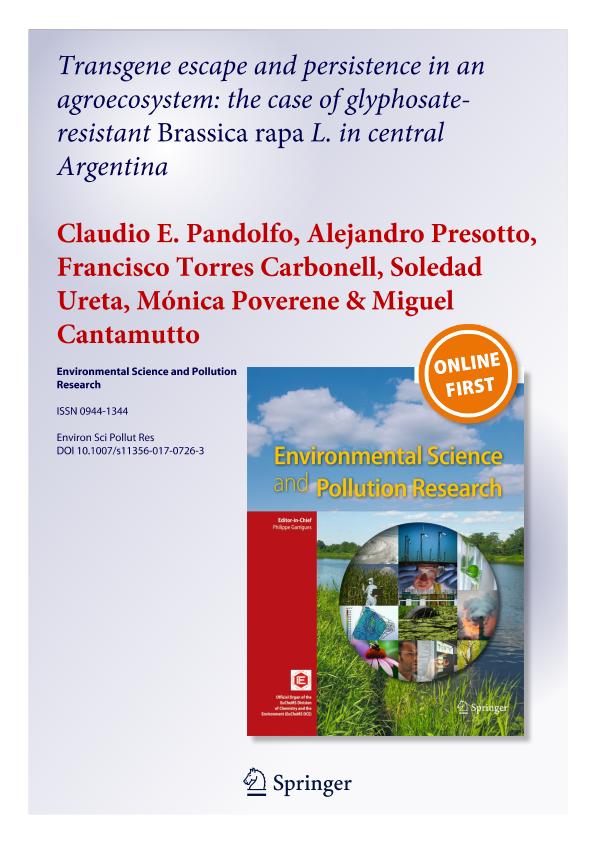Mostrar el registro sencillo del ítem
dc.contributor.author
Pandolfo, Claudio Ezequiel

dc.contributor.author
Presotto, Alejandro Daniel

dc.contributor.author
Torres Carbonell, Francisco Javier

dc.contributor.author
Ureta, Maria Soledad

dc.contributor.author
Poverene, María Mónica

dc.contributor.author
Cantamutto, Miguel Ángel

dc.date.available
2018-01-29T18:55:55Z
dc.date.issued
2017-12-14
dc.identifier.citation
Pandolfo, Claudio Ezequiel; Presotto, Alejandro Daniel; Torres Carbonell, Francisco Javier; Ureta, Maria Soledad; Poverene, María Mónica; et al.; Transgene escape and persistence in an agroecosystem: the case of glyphosate-resistant Brassica rapa L. in central Argentina; Springer; Environmental Science and Pollution Research; 14-12-2017; 1-14
dc.identifier.issn
0944-1344
dc.identifier.uri
http://hdl.handle.net/11336/34928
dc.description.abstract
Brassica rapa L. is an annual Brassicaceae species cultivated for oil and food production, whose wild form is a weed of crops worldwide. In temperate regions of South America and especially in the Argentine Pampas region, this species is widely distributed. During 2014, wild B. rapa populations that escaped control with glyphosate applications by farmers were found in this area. These plants were characterized by morphology and seed acidic profile, and all the characters agreed with B. rapa description. The dose-response assays showed that the biotypes were highly resistant to glyphosate. It was also shown that they had multiple resistance to AHAS-inhibiting herbicides. The transgenic origin of the glyphosate resistance in B. rapa biotypes was verified by an immunological test which confirmed the presence of the CP4 EPSPS protein and by an event-specific GT73 molecular marker. The persistence of the transgene in nature was confirmed for at least 4 years, in ruderal and agrestal habitats. This finding suggests that glyphosate resistance might come from GM oilseed rape crops illegally cultivated in the country or as a seed contaminant, and it implies gene flow and introgression between feral populations of GM B. napus and wild B. rapa. The persistence and spread of the resistance in agricultural environments was promoted by the high selection pressure imposed by intensive herbicide usage in the prevalent no-till farming systems.
dc.format
application/pdf
dc.language.iso
eng
dc.publisher
Springer

dc.rights
info:eu-repo/semantics/openAccess
dc.rights.uri
https://creativecommons.org/licenses/by-nc-sa/2.5/ar/
dc.subject
Transgenic Crops
dc.subject
Gene Flow
dc.subject
Herbicide Resistance
dc.subject
Wild Turnip
dc.subject
Ogm
dc.subject
Hybridization
dc.subject
Introgression
dc.subject.classification
Agricultura

dc.subject.classification
Agricultura, Silvicultura y Pesca

dc.subject.classification
CIENCIAS AGRÍCOLAS

dc.title
Transgene escape and persistence in an agroecosystem: the case of glyphosate-resistant Brassica rapa L. in central Argentina
dc.type
info:eu-repo/semantics/article
dc.type
info:ar-repo/semantics/artículo
dc.type
info:eu-repo/semantics/publishedVersion
dc.date.updated
2018-01-19T18:34:43Z
dc.identifier.eissn
1614-7499
dc.journal.pagination
1-14
dc.journal.pais
Alemania

dc.description.fil
Fil: Pandolfo, Claudio Ezequiel. Universidad Nacional del Sur. Departamento de Agronomía; Argentina. Consejo Nacional de Investigaciones Científicas y Técnicas. Centro Científico Tecnológico Conicet - Bahía Blanca. Centro de Recursos Naturales Renovables de la Zona Semiárida. Universidad Nacional del Sur. Centro de Recursos Naturales Renovables de la Zona Semiárida; Argentina
dc.description.fil
Fil: Presotto, Alejandro Daniel. Universidad Nacional del Sur. Departamento de Agronomía; Argentina. Consejo Nacional de Investigaciones Científicas y Técnicas. Centro Científico Tecnológico Conicet - Bahía Blanca. Centro de Recursos Naturales Renovables de la Zona Semiárida. Universidad Nacional del Sur. Centro de Recursos Naturales Renovables de la Zona Semiárida; Argentina
dc.description.fil
Fil: Torres Carbonell, Francisco Javier. Universidad Nacional del Sur. Departamento de Agronomía; Argentina
dc.description.fil
Fil: Ureta, Maria Soledad. Universidad Nacional del Sur. Departamento de Agronomía; Argentina. Consejo Nacional de Investigaciones Científicas y Técnicas. Centro Científico Tecnológico Conicet - Bahía Blanca. Centro de Recursos Naturales Renovables de la Zona Semiárida. Universidad Nacional del Sur. Centro de Recursos Naturales Renovables de la Zona Semiárida; Argentina
dc.description.fil
Fil: Poverene, María Mónica. Universidad Nacional del Sur. Departamento de Agronomía; Argentina. Consejo Nacional de Investigaciones Científicas y Técnicas. Centro Científico Tecnológico Conicet - Bahía Blanca. Centro de Recursos Naturales Renovables de la Zona Semiárida. Universidad Nacional del Sur. Centro de Recursos Naturales Renovables de la Zona Semiárida; Argentina
dc.description.fil
Fil: Cantamutto, Miguel Ángel. Instituto Nacional de Tecnología Agropecuaria. Centro Regional Buenos Aires Sur. Estación Experimental Agropecuaria Hilario Ascasubi; Argentina. Universidad Nacional del Sur. Departamento de Agronomía; Argentina
dc.journal.title
Environmental Science and Pollution Research

dc.relation.alternativeid
info:eu-repo/semantics/altIdentifier/url/http://link.springer.com/10.1007/s11356-017-0726-3
dc.relation.alternativeid
info:eu-repo/semantics/altIdentifier/doi/http://dx.doi.org/10.1007/s11356-017-0726-3
Archivos asociados
